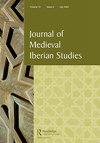The crystal codex: Iacobus, Galicia, and the dream of the archive
IF 0.4
2区 历史学
0 MEDIEVAL & RENAISSANCE STUDIES
引用次数: 0
Abstract
ABSTRACT This essay focuses on two previously unpublished photographs of the Dream of Charlemagne, one of most famous illuminations from the twelfth-century Codex Calixtinus (Santiago Cathedral Library, MS. CF 14), which allow the reconstruction of details of its composition that seemed to have been lost. The search for these photographs goes parallel with an immersion in the archive of the Seminario de Estudos Galegos, a research institution that was preparing the first modern edition of the Codex Calixtinus, including photographs of its illuminations, when the Spanish Civil War broke out in 1936. The Seminario was closed down after the war by the Francoist regime leaving the scattered galleys of the Codex Calixtinus edition as its last ruined monument. I propose a Benjaminian pilgrimage through the archive of the Seminario, taking the Dream of Charlemagne as a “dialectical image” allowing us to meditate on the historical processes to which this illumination bears witness. The article engages with the theory and materiality of photography, the archaeology of archives, and the significance of medieval manuscripts as national emblems in the twentieth century. As a coda, it reveals the medieval model inspiring Paul Klee's Angelus Novus, turned by Walter Benjamin into an image of his “angel of history.”水晶手抄本:亚柯布斯、加利西亚和档案之梦
这篇文章的重点是以前未发表的两张查理曼梦的照片,这是12世纪卡利克斯提努斯抄本(圣地亚哥大教堂图书馆,MS. CF 14)中最著名的插图之一,它们可以重建其构图细节,这些细节似乎已经丢失了。寻找这些照片的同时,还沉浸在加莱戈斯神学院(Seminario de Estudos Galegos)的档案中,这家研究机构正在准备《卡利斯提努斯抄本》(Codex Calixtinus)的第一个现代版本,其中包括其插图的照片,当时西班牙内战于1936年爆发。战争结束后,佛朗哥政权关闭了神学院,留下了《卡利克斯提努斯法典》(Codex Calixtinus)版本的零星帆船作为最后的废墟纪念碑。我提出了一个本雅明的朝圣之旅,通过神学院的档案,把查理曼之梦作为一个“辩证的图像”,让我们思考这个启示见证的历史进程。本文涉及摄影的理论和物质性,档案考古学,以及20世纪中世纪手稿作为国家象征的意义。作为结尾,它揭示了启发保罗·克利的《新天使》的中世纪模式,被沃尔特·本雅明变成了他的“历史天使”形象。
本文章由计算机程序翻译,如有差异,请以英文原文为准。
求助全文
约1分钟内获得全文
求助全文
来源期刊

Journal of Medieval Iberian Studies
MEDIEVAL & RENAISSANCE STUDIES-
CiteScore
1.20
自引率
20.00%
发文量
24
 求助内容:
求助内容: 应助结果提醒方式:
应助结果提醒方式:


